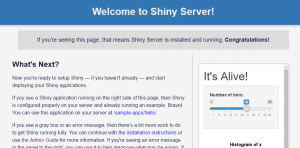HowTo Install R Shiny Server in Centos 7/RHEL 7 Guide
Shiny is an R package that makes it easy to build interactive web applications (apps) straight from R. This lesson will get you started building Shiny apps right away. Opensource and Enterprise ready professional software for the R Community. In this Article we are going to see HowTo install R shiny Server in Centos 7/RHEL 7.
It’s widely used to generate HTML 5+CSS application by writing R language code simply. write small piece of code It will auto generate application with .R extension and run from R shiny server using web browser.
Environment:
- Server machine installed with Centos 7
- Sudo User Or Root User Access for Installation
Setup Host Name
# hostnamectl set-hostname rshiny --static # systemctl restart systemd-hostnamed.service
Configure YUM for Packages Installation
Use below two commands to enable EPEL Repository
# wget http://dl.fedoraproject.org/pub/epel/7/x86_64/e/epel-release-7-9.noarch.rpm # rpm -ivh epel-release-7-9.noarch.rpm
Install R Shiny Server in Centos 7
# yum install R
It installs around 376 packages by resolving dependencies all together
Now run R package installation command
# su - \
-c "R -e \"install.packages('shiny', repos='https://cran.rstudio.com/')\""
Rd warning: /tmp/RtmpsqdM5t/R.INSTALL5114625d5c82/shiny/man/updateSelectInput.Rd:35: missing file link ‘I’
updateSliderInput html
updateTabsetPanel html
updateTextAreaInput html
updateTextInput html
urlModal html
validate html
validateCssUnit html
verbatimTextOutput html
verticalLayout html
viewer html
wellPanel html
withMathJax html
withProgress html
withTags html
** building package indices
** testing if installed package can be loaded
* DONE (shiny)
Making 'packages.html' ... done
The downloaded source packages are in
‘/tmp/RtmpoL151g/downloaded_packages’
Updating HTML index of packages in '.Library'
Making 'packages.html' ... done
>
>
Download R Shiny Server Package and Install
# wget https://download3.rstudio.org/centos5.9/x86_64/shiny-server-1.4.2.786-rh5-x86_64.rpm # yum install --nogpgcheck shiny-server-1.4.2.786-rh5-x86_64.rpm
Shiny-server install successfully after that enable and start services
# systemctl enable shiny-server
# systemctl start shiny-server
# systemctl status shiny-server
● shiny-server.service - ShinyServer
Loaded: loaded (/etc/systemd/system/shiny-server.service; enabled; vendor preset: disabled)
Active: active (running) since Thu 2017-06-22 13:40:24 AWST; 33s ago
Main PID: 20806 (shiny-server)
Allow / Enable Firewall Ports
# firewall-cmd --permanent --add-port=3838/tcp success # firewall-cmd --permanent --add-port=3838/udp success # firewall-cmd --reload success
3838 is the default port number used by shiny-server application
Access Shiny Server from Browser
http://localhost:3838
Test R shiny Server Installation from command Line Interface also
That’s it your R Shiny Server installed successfully, Rock to Build new applications using R Language
Related Articles
DHCP Server Installation and Configuration Centos 7
NFS Server installation and configuration RHEL 7
Thanks for your wonderful Support and Encouragement
- Get Email | Download E-Books
- Facebook Page
- Youtube Channel
- Exclusive Telegram Group
- Discuss On WhatsApp Group









good job boy
-c “R -e \”install.packages(‘shiny’, repos=’https://cran.rstudio.com/’)\””
The above command fails to install httpuv package